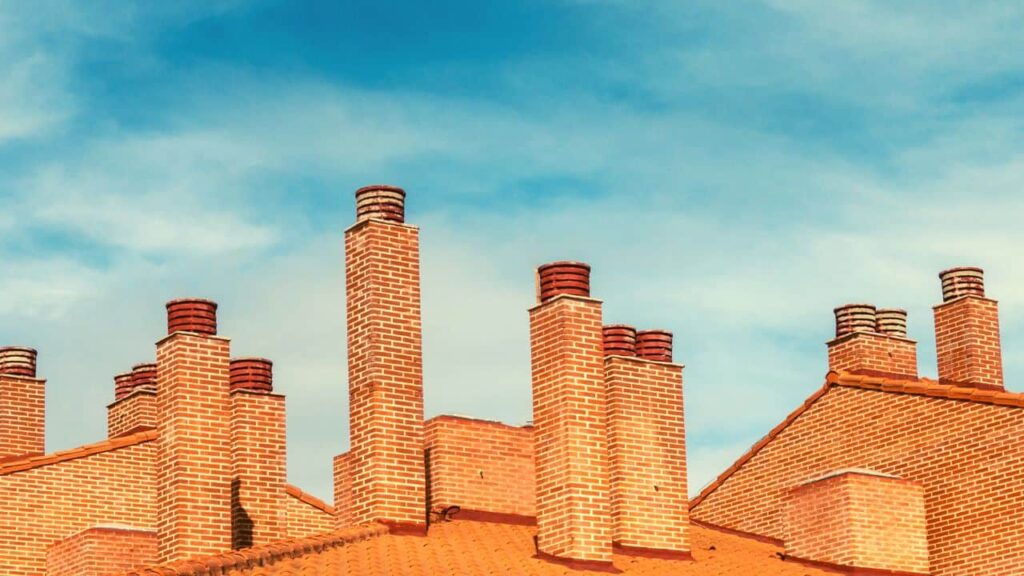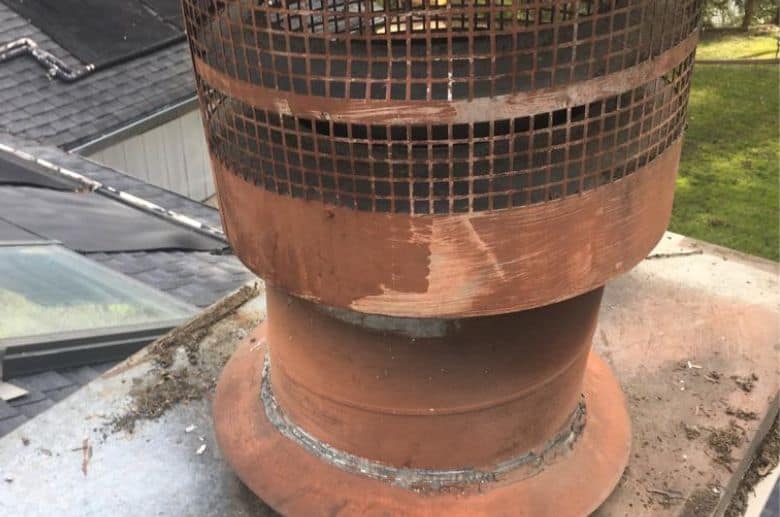When talking about the chimney, many people picture the fireplace. A chimney is more than just a fireplace.
The part of the chimney above the roof is known as the chimney stack, and it is the most exposed part of a structure, affected by all weather conditions.
Over time, the chimney stack deteriorates due to damage from weather elements and a lack of regular maintenance. This affects the performance of your chimney and eventually can lead to loose bricks that can end up falling and hurting pedestrians that walk near your home.
In this post, we will discuss the functions of the stack, common issues that affect it, and how much it costs to repair a damaged one.
What is a chimney stack?

A chimney stack is the section of the chimney that emerges from your home’s roof. It is the most visible part of your chimney. stacks can be made of wood, stone, or brick. These materials protect the chimney from destructive elements such as rain, snow, and debris.
The chimney stack is an important component as it directs soot, smoke, and toxic gasses like carbon monoxide away from your home.
Parts of a chimney stack
it’s important to know the different parts of the stack, and what they do so you can identify any issues and fix them quickly.
Flue liner
Inside the stack, you can find the flue liner. The flue is the vertical section of the chimney where combustion byproducts like soot and smoke from the fireplace move up and away from your home.
The most common flue liner material is clay tile. It is an affordable and durable option. Chimney liners help regulate the temperatures in the fireplace, ensuring that your home is protected from deadly chimney fires.
Other materials you can use as chimney liners are stainless steel and aluminum. The latter is commonly installed in gas fireplaces.
Other components found on the chimney stack
Chimney crown – A concrete slab that covers the top of the chimney in masonry chimneys. Chimney crowns are made with slanting sides to prevent water from moisture from damaging the masonry.
If there are cracks in the chimney crown, water will seep into your chimney and cause structural damage. We recommend contacting a reliable chimney sweep if you have a cracked chimney crown.
Chimney cap – Unlike the chimney crown, it covers only the flue opening and prevents rain, snow, and debris from getting into the chimney.
Chimney caps have mesh sidings to keep animals like squirrels, bats, and birds away. The mesh also functions as a spark guard to prevent roof fires.
Chimney chase cover – This component covers the top of a prefab chimney and can be made of materials like galvanized steel, stainless steel, aluminum, and copper. Like the crown in masonry chimneys, it keeps rain and snow away from the chimney.
How long does a chimney stack last?
A chimney stack can last up to 50 years. This is also its average lifecycle. However, If you neglect your chimney, Most likely, it will not last that long. Ensure you schedule chimney cleaning and inspection annually to ensure the longevity of your chimney.
Common external chimney stack defects
The chimney stack is a vital part of your chimney. If it is damaged, it will not protect your chimney, and you will probably spend hundreds or thousands of dollars on repairs if you don’t fix the issues early. The following are the common stack defects:
1. Roof leaking around the chimney stack
Water can wreak havoc on your chimney. If your chimney is not well protected, water will enter and cause significant damage, especially if you don’t take steps to deal with it.
Ways to protect your chimney stack from water damage include installing a chimney cap, a chimney crown, and waterproofing the masonry.
Some external damages can cause water to seep into your chimney, including deteriorating brick and mortar, cracked chimney caps, and bad flashing.
Also, when there is too much moisture in the chimney structure, your roof will leak around the chimney. This requires immediate attention as the damage will extend to the walls.
If you notice signs of water damage around the chimney, like spalling bricks, contact an experienced chimney technician immediately for an inspection.
——
Do You Need to Hire Chimney & Fireplace Expert?
Get free quotes from qualified experts near you. No commitment required!
——
2. Loose bricks inside the chimney stack

According to Metropolitan Engineering Consulting & Forensics Services, water is a leading cause of masonry chimney failures. During winter, water entering the chimney freezes and expands, making the bricks crumble and crack.
This kind of water damage typically goes unnoticed inside the chimney.
You may realize there is an issue when it’s too late and the damages have become extensive.
If your masonry chimney has been exposed to water for a long time, you will have to rebuild part of the chimney. This means you may spend hundreds or thousands of dollars redoing the brickwork.
Arranging for a yearly chimney inspection is the best way to ensure the bricks inside the stack aren’t exposed to excessive moisture.
3. Leaning chimney stack
Water leaking through the chimney makes the brick-and-mortar deteriorate. The masonry keeps the stack upright, so if it is weakened, it will probably lean.
When your chimney leans, it means it has been exposed to water leaks for a long time. The good thing is that you can tell if your chimney is likely to bend.
Look for obvious signs of water damage, such as stains on the exterior bricks, water leaking in the area around the chimney, and damp spots on the walls near your chimney.
A leaning chimney can have a negative effect on the structural integrity of your house and can lead to costly repairs. If your chimney is leaning, get in touch with a qualified chimney sweep immediately.
4. Damaged chimney cap or chimney pot

A chimney cap prevents rainwater from getting into the chimney and has a mesh siding to keep away debris and animals. On the other hand, a chimney pot makes the smokestack taller, ensuring a better draft.
If you have a damaged chimney cap or pot, water and snow will enter your chimney and cause the deterioration of chimney components such as the liner and damper.
Chimney stack types
There are two main types of chimney stacks:
Metal chimney stack

Metal chimney stacks are common in prefabricated (factory-built) and metal chimneys. In prefab chimneys, the firebox, flue pipe, and chimney cap are made of metals like stainless steel, galvanized steel, and copper
Factory-built chimneys are easier to install, and you can choose from various designs.
Brick chimney stack
Brick chimney stacks are quite common, and they are built on-site. The bricks are held together by mortar and can function normally for decades if you take good care of them.
We recommend scheduling yearly chimney sweep inspections to ensure brick chimney don’t deteriorate and cause water damage.
——
Do You Need to Hire Chimney & Fireplace Expert?
Get free quotes from qualified experts near you. No commitment required!
——
How high should my chimney stack be?
We recommend using the 3 2 10 chimney rule when determining your chimney stack’s ideal height. The code states that the chimney’s shortest side needs to be 3 feet above the highest structure on the roof and 2 feet above any element on the roof that’s within 10 feet.
What is the difference between chimney breasts and chimney stacks?
A chimney stack is the part of the chimney above a house’s roof. The stack encases the flue, which carries smoke and dangerous gasses out of your home.
On the other hand, a chimney breast is a structure that protrudes outwards into a room to create space for the fireplace and is usually found on a building’s ground floor.
In some cases, many homeowners decide to remove chimney breasts to create more floor space in the room.
Chimney Stack Cost
The cost of a chimney stack varies depending on several factors, Ultimately, the best way to determine its cost is to consult with a professional who can assess the specific requirements of your project.
Factors that can influence chimney stack cost include:
Materials – The materials you use will determine the final cost. For instance, there are several brick types, and all come at different prices.
Damage – The cost will be higher if parts of your chimney, such as the crown, are damaged.
Labor – You will pay more if a big team works on your chimney.
Chimney size – Restoring or rebuilding large chimneys costs more.
Check chimney stack cost in the table below:
| Chimney stack | Cost |
| Chimney stack repair | $500-$2500 |
| Rebuild chimney stack cost (single flue) | $1000-$3500 |
| Rebuild chimney stack cost (double flue) | $1000-$4000 |
| Chimney stack removal cost | $1000-$2000 |
Conclusion
A chimney stack is a vital chimney component. It removes your house’s smoke, soot, creosote, and toxic gasses. Over time, your chimney will start deteriorating. Annual chimney inspection will ensure it stays in good condition and functions well.






